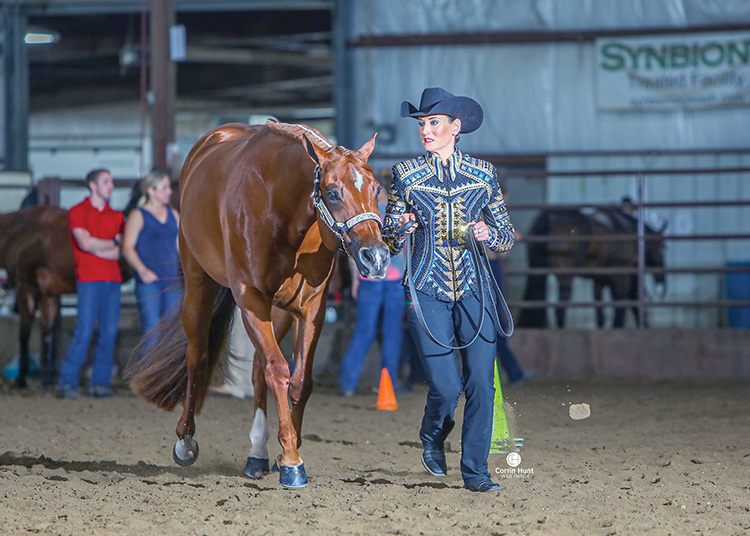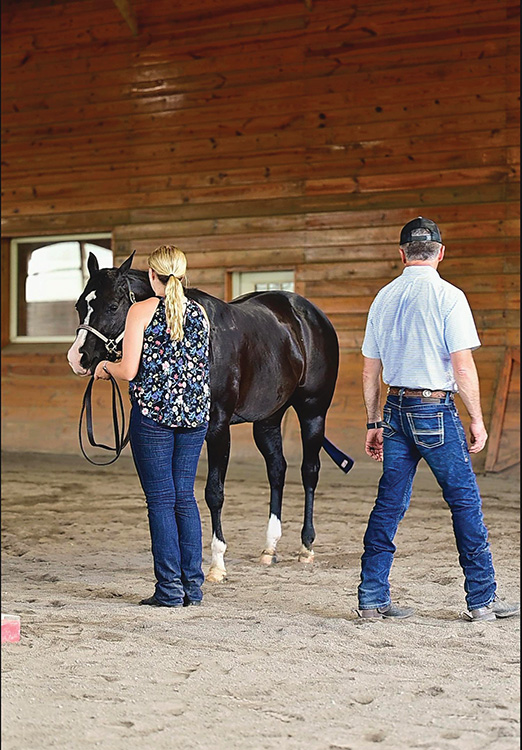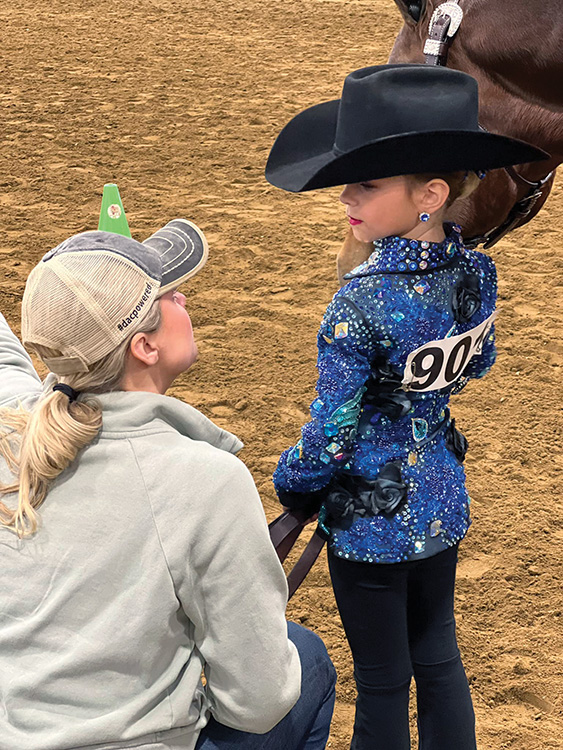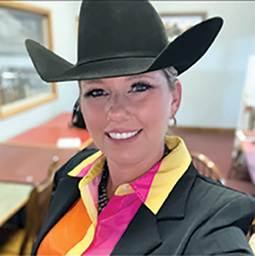We’ve all seen it – those competitors in a Showmanship class who “run funny.”
Maybe they stick their behind out too far. Maybe they resemble a duck. Or maybe they are just running on their toes and their stride appears off.
Many times, this is happening unfortunately because handlers simply don’t know the correct way to run beside their horse to present an attractive picture overall that puts the focus where it needs to be – on their horse.
Here successful Showmanship competitors, trainers, coaches and judges offer their advice on perfect the Showmanship run, no matter if you compete in American Quarter Horse Association (AQHA) American Paint Horse Association (APHA) the National Snaffle Bit Association (NSBA) or any other stock horse event.
How a Handler’s Run Can Impact the Horses Performance
You may not think the way you run beside your horse during Showmanship has much of an impact on the outcome of the class. But that’s not usually the case.
“A handlers run is directly related to how a horse performs at a trot,” said New Jersey trainer and AQHA and NSBA carded judge Pierre Briere. “A handler who has balance, is flat footed, has pace and shows strength and control in their upper body at the trot is more likely to have a good solid, balanced, and synchronized stop.”
Keep in mind when practicing that even though we all try to trot and stop with as high a degree of difficulty as possible, you as a handler weigh a fraction of what your horse weighs, so be realistic and understand that a 1,000-pound horse cannot stop as hard as you the handler.
“For example, if you weigh 120 pounds you should not expect your 1,100 pound partner to stop as abruptly as you can, so practice a trot to stop that fits you as a team,” Briere said.
Good Showmanship horses Will Always Work Off Their Handler’s Body“
A good run has as much to do with a judges’ perception as it does with the exhibitor and horses’ performance, according to AQHA judge Mark Russell, of Perry, Arkansas.
“You make the judge’s job easier if they can see and score maneuvers without being distracted by flying feet, rising knees or swinging shoulders,” he explained.
Both Russell and AQHA and NSBA judge Bobbie Jo Stanton, of Shawnee, Oklahoma, say they notice that too often exhibitors fail to run in an upright manner.
“They tend to squat in their knees or their hips, and most of the time, this really distracts from the overall picture,” she explained.
What Winning Exhibitors Are Doing Right
Watching a winning exhibitors run is a great way to understand what a good run is supposed to look like.
“Winning exhibitors carry themselves upright, their shoulders remain in place, and do not swing,” Russell said. “They carry their hips in a position that allows their legs to move and their upper body to remain quiet.
What exhibitors should aim for is minimal upper and lower body movement that is not rigid and movements are soft.
“The biggest thing is to minimize motion while never appearing stiff or rigid,” Russell said.
Patricia Bogosh, of Arlington Heights, Illinois, who won the Amateur Showmanship at the 2023 NSBA World Show, says that a good Showmanship run should look like you’re floating over the dirt with a heel to toe movement while being in sync with your horse.
“Just like we like our horses to have flatter knees and grace when they move, that is how your run should look,” she explained. “Stable shoulders, a strong core and engagement from your posterior chain presents a pretty picture.”
Judges also favor a run where the horse and handler are synchronized and not interfering with one another.
“A willfully guided horse that trots at a synchronized pace with his handler, a horse and exhibitor that look, in their demeanor and presentation, eager to perform,” Briere said. “A horse and handler team that perform a trot in a straight or bending line parallel from each other and without interference from each other.”
Winning exhibitors develop a style that is suitable for them and their horses. However, multiple styles can look good if they are postured correctly and in unison with their horse.
“I think the biggest thing I’d like to commend our top tier of Showmanship competitors on is their ability to perform in unison with their horse,” Stanton said. “I like to think of Showmanship as a dance and nothing is more pleasing to watch than a horse and exhibitor hooked up and in sync. These exhibitors are running in a quiet and upright manner, and not drawing undue attention to their arms or legs. Everything seems seamless and effortless. It seems effortless because countless hours have clearly been put into their practice and preparation and it shows.”
Practicing and Perfecting Your Showmanship Run
Savvy competitors, trainers and judges agree, your height and weight and your horse’s build are all factors that need to be considered when working through your Showmanship run.
“We have members on our team who are tall, long, and lean showing 15-hand horses as well as smaller statured women showing 16-hand horses,” Russell said. “It’s not easier for either of them, but both combinations have been successful.
Striding with the horse falls second to body carriage.
“An exhibitor who can carry themselves smoothly and cover ground without drawing attention to any particular movement will do well with any size animal,” Russell added.
Briere emphasized that the most important thing is to find a comfortable running pace, regardless of your age, height, weight or physical limitations.
“Find the pace that suits you best, practice it, and smooth it out as best as you can,” he said.
Knowing what you need work on is the best first step.
“Have someone video you as you work on areas of weakness so you can see the change as you’re addressing it,” Bogosh suggested. “You can feel like you’re doing one thing, but it may look completely different.”
Iowa AQHA, NSBA and APHA judge Shannon Walker has coached numerous Showmanship winners. She says it’s important that competitors practice their overall game plan and urges them to remember that confidence is another aspect of a good Showmanship run and it’s one that can also be practiced at home. She has created a process for setting and turning and she constantly reminds clients that if they use that process, it will continuously get quicker because horses also learn the process.
“When we set, we lift up to move the front and down to move the back feet and we encourage them to move the left hind while setting.,” she explained. “This establishes the right foot as a plant foot that doesn’t move.”
The stop is another aspect that shouldn’t be overlooked when practicing.
“I prefer a stop that looks like they’re stopping from their hind end vs falling forward on their front end. I do a lot of forward straight to backward exercises without putting a stop in between,” Bogosh explained. “This gets the horse to pick up their back and move off your body during your maneuvers. I use the chain for steering only – meaning if I have to use the chain to move them forward or back, they are too heavy.”
Bogosh wants her horse to move off her body and be in sync with what her body is doing.
“You should always be consistent in what foot you start and stop with, so they learn consistency from you,” she said. “When I start a new one in Showmanship, I spend the most time getting in sync with its gait, so they learn first how to follow my body.”
Do Your Homework
Many judges say watching successful Showmanship competitors to study their body language and the length of the steps they take through a maneuver, is a great way to learn how a good run should look.
But nothing compares to daily practice when it comes to improving your Showmanship skills.
“We have used a full cup of water in the lead hand practicing Showmanship for decades to minimize hand and shoulder motion,” Russell said. “We also have clients stand and fill their diaphragm, feel their ribcage rise, then hold the position while in motion. The torso must remain suspended to allow the hips to move properly and keep from having a lot of motion in the knees and feet.”
Russell said the one true exercise that never fails to make a difference for clients is something called “the wall.”
“Stand with your shoulders, hips, heels and head backed against a wall with your hands in a Showmanship position,” he said. “When stepping away from the wall, the hips must lead.”
Have a friend video you practicing the exercise but remember, the hips must always lead.
“This creates the optimal body position while in motion,” Russell said.
The Right Fit
Competitors and coaches all agree that taking care of details, like properly fitted equipment and attire ahead of time helps with both the practice stage and with the actual competition.
“If you have ill-fitting boots, you have to fight with your attire while you’re trying to improve your run,” she said. “Invest in your equipment that will help you be successful.”
Remember: AQHA says Showmanship is designed to evaluate the exhibitor’s ability to execute, in concert with a well-groomed and conditioned horse, a set of maneuvers prescribed by the judge with precision and smoothness while exhibiting poise and confidence, and maintaining a balanced, functional and fundamentally correct body position.”







You must be logged in to post a comment Login